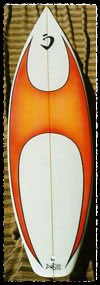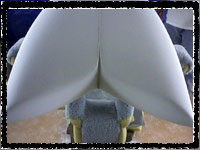Custom Surfboards

The past two decades have almost redefined high-performance surfboard design and manufacture. Not only has surfboard design and performance evolved substantially, but it has also taken on many facets over the years. Manufacturing capabilities, technological boundaries, and even geographic presence have simply exploded globally. Surfboard manufacturing technology has advanced to include things like CAD design and computer controlled shaping systems. Despite the controversies surrounding boards manufactured offshore, many advances in our industry have been achieved. Here at Jonesbrand, we would like to take the opportunity to acknowledge and thank the leaders and innovators of the surfing industry. You know who they are… many have been household names for decades. These titans have achieved many successes and milestones which sets them apart from the average backyard shaper. They have set the bar, and in doing so have helped shape our own vision, style, and voice.
From a design perspective, I believe the current trend is a complementary blend of popular design, combined with a refreshing infusion of historic or "retro-styled" influence. The future holds a complex mix of a seemingly inexhaustible variety of templates joined with virtually endless combinations of rocker, rail, and bottom design. This level of innovation and creativity means surfboard design is no longer held hostage in a static state, and has finally moved away from the paper-thin "toothpick sticks" of the late 80's and early 90's. The focus is back to the more fundamental, functional aspects of surfboard design. More attention to detail, in terms of the important relationships between shaping components, yields a board that is a natural extension of the surfer. Nothing is worse than a board that either has to be conquered or endured.


I believe moving forward, we'll continue to see more subtle rocker and rail-line adjustments. Also a more reasonable balance between volume and foil will enhance performance and promote less breakage. I think we'll see a more positive volume returning to board shaping based solely on performance instead of aesthetics. Rails are also a very important and complex component of shaping today's modern boards. Rail systems and bottom deck design remain very dynamic and can change dramatically from rider to rider. As far as bottoms are concerned, I prefer using a fast but loose bottom, combining both flat areas and varying amounts of concave. But again, different combinations work for different riders. Fin systems can be anything from conventional to experimental fin set-ups utilizing a wide range of removable fin systems, which also gives our riders more flexibility and versatility.
All of these things lead us to the most important part of modern surfboard design... communication. Communication between surfer and shaper is probably the most important tool of all. Surfers representing everyone from the "purist" to the "innovator" have helped develop and strengthen the core design attributes of modern surfboard manufacture. The more feedback our riders can give us, the more we'll have to offer in return.

Mahalo!

